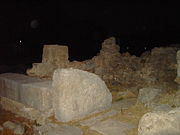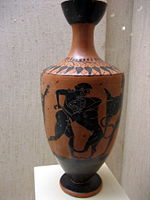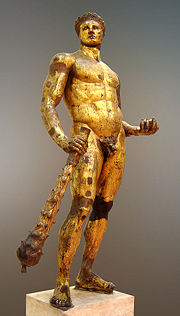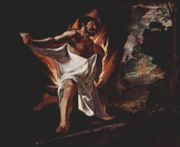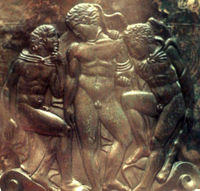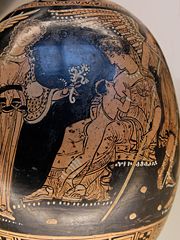Heracles
2008/9 Schools Wikipedia Selection. Related subjects: Ancient History, Classical History and Mythology
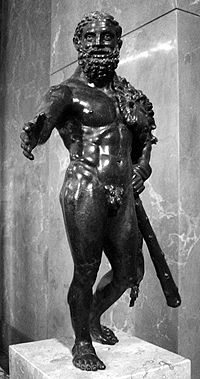
In Greek mythology, Heracles or Herakles ("glory of Hera", or "Glorious through Hera," Alcides or Alcaeus (original name) "Ἥρα + κλέος, Ἡρακλῆς)" was a divine hero, the son of Zeus and Alcmene, nephew of Amphitryon and great-grandson (and half-brother) of Perseus. He was the greatest of the Greek heroes, a paragon of masculinity, the ancestor of royal clans who claimed to be Heracleidae and a champion of the Olympian order against chthonic monsters. In Rome and the modern West, he is known as Hercules, with whom the later Roman Emperors, in particular Commodus and Maximian, often identified themselves. The Romans adopted the Greek version of his life and works essentially unchanged, but added anecdotal detail of their own, some of it linking the hero with the geography of the Central Mediterranean. Details of his cult were adapted to Rome as well.
Extraordinary strength, courage, ingenuity, and sexual prowess with both males and females were among his characteristic attributes. Although he was not as clever as the likes of Odysseus or Nestor, Heracles used his wits on several occasions when his strength did not suffice, such as when laboring for the king Augeas of Elis, wrestling the giant Antaeus, or tricking Atlas into taking the sky back onto his shoulders. Together with Hermes he was the patron and protector of gymnasia and palaestrae. His iconographic attributes are the lion skin and the club. These qualities did not prevent him from being regarded as a playful figure who used games to relax from his labors and played a great deal with children. By conquering dangerous archaic forces he is said to have "made the world safe for mankind" and to be its benefactor. Heracles was an extremely passionate and emotional individual, capable of doing both great deeds for his friends (such as wrestling with Thanatos on behalf of Prince Admetus, who had regaled Heracles with his hospitality, or restoring his friend Tyndareus to the throne of Sparta after he was overthrown) and being a terrible enemy who would wreak horrible vengeance on those who crossed him, as Augeas, Neleus and Laomedon all found out to their cost.
Origin and character
Many popular stories were told of his life, the most famous being The Twelve labors of Heracles; Alexandrian poets of the Hellenistic age drew his mythology into a high poetic and tragic atmosphere. His figure, which initially drew on Near Eastern motifs such as the lion-fight, was known everywhere: his Etruscan equivalent was Hercle, a son of Tinia and Uni.
Heracles was the greatest of Hellenic chthonic heroes, but unlike other Greek heroes, no tomb was identified as his. Heracles was both hero and god, as Pindar says heroes theos; at the same festival sacrifice was made to him, first as a hero, with a chthonic libation, and then as a god, upon an altar: thus he embodies the closest Greek approach to a " demi-god". The core of the story of Heracles has been identified by Walter Burkert as originating in Neolithic hunter culture and traditions of shamanistic crossings into the netherworld.
Hero or god?
Heracles' role as a culture hero, whose death could be a subject of mythic telling (see below), was accepted into the Olympian Pantheon during Classical times. This created an awkwardness in the encounter with Odysseus in the episode of Odyssey XI, called the Nekuia, where Odysseus encounters Heracles in Hades:
- And next I caught a glimpse of powerful Heracles—
- His ghost I mean: the man himself delights
- in the grand feasts of the deathless gods on high...
- Around him cries of the dead rang out like cries of birds
- scattering left and right in horror as on he came like night..."
- His ghost I mean: the man himself delights
Ancient critics were aware of the problem of the aside that interrupts the vivid and complete description, in which Heracles recognizes Odysseus and hails him, and modern critics find very good reasons for denying that the verses beginning, in Fagles' translation His ghost I mean... were part of the original composition: "once people knew of Heracles' admission to Olympus," they would not tolerate his presence in the underworld," remarks Friedrich Solmsen, noting that the interpolated verses represent a compromise between conflicting representations of Heracles.
Christian dating
In Christian circles a Euhemerist reading of the widespread Heracles/Hercules cult was attributed to a historical figure who had been offered cult status after his death. Thus Eusebius, Preparation of the Gospel (10.12), reported that Clement could offer historical dates for Hercules as a king in Argos: "from the reign of Hercules in Argos to the deification of Hercules himself and of Asclepius there are comprised thirty-eight years, according to Apollodorus the chronicler: and from that point to the deification of Castor and Pollux fifty-three years: and somewhere about this time was the capture of Troy."
Readers with a literalist bent, following Clement's reasoning, have asserted from this remark that, since Heracles ruled over Tiryns in Argos at the same time that Eurystheus ruled over Mycenae, and since at about this time Linus was Heracles' teacher, one can conclude, based on Jerome's date—in his universal history, his Chronicon—given to Linus' notoriety in teaching Heracles in 1264 BCE, that Heracles' death and detification occurred 38 years later, in approximately 1226 BCE.
Cult of Heracles
The ancient Greeks celebrated the festival of the Herakleia, which commemorated the death of Heracles, on the second day of the month of Metageitnion (which would fall in late July or early August). What is believed to be an Egyptian Temple of Heracles in the Bahariya Oasis dates to 21 BCE.
Myths of Heracles
Birth and childhood
| Topics in Greek mythology |
|---|
|
|
|
A major factor in the well-known tragedies surrounding Heracles is the hatred that the goddess Hera, wife of Zeus, had for him. A full account of Heracles must render it clear why Heracles was so tormented by Hera, when there are many illegitimate offspring sired by Zeus. Heracles was the fruit of the affair Zeus had with the mortal woman Alcmene. Zeus made love to her after disguising himself as her husband, Amphitryon, home early from war (Amphitryon did return later the same night, and Alcmene became pregnant with his son at the same time, a case of superfecundation, where a woman carries twins sired by different fathers). Thus, Heracles' very existence proved at least one of Zeus' many illicit affairs, and Hera often conspired against Zeus' mortal offspring, as revenge for her husband's infidelities. His twin mortal brother, son of Amphitryon was Iphicles, father of Heracles' charioteer Iolaus.
On the night the twins sharing the same mother were to be born, Hera, knowing of her husband Zeus' adultery, persuaded Zeus to swear an oath that the child born that night to a member of the House of Perseus would be High King. Once the oath was sworn, Hera hurried to Alcmene's dwelling and slowed the birth by forcing Ilithyia, goddess of childbirth, to sit crosslegged with her clothing tied in knots, thereby causing Heracles to be trapped in the womb. Meanwhile, Hera caused Eurystheus to be born prematurely, making him High King in place of Heracles. She would have permanently delayed Heracles' birth had she not been fooled by Galanthis, Alcmene's servant, who lied to Ilithyia, saying that Alcmene had already delivered the baby. Upon hearing this, she jumped in surprise, untying the knots and inadvertently allowing Alcmene to give birth.
The child was originally given the name Alcides by his parents; it was only later that he became known as Heracles. He was renamed Heracles in an unsuccessful attempt to mollify Hera. A few months after he was born, Hera sent two serpents to kill him as he lay in his cot. Heracles throttled a snake in each hand and was found by his nurse playing with their limp bodies as if they were child's toys.
Youth
After killing his music tutor Linus with a lyre, he was sent to tend cattle on a mountain by his foster father Amphitryon. Here, according to an allegorical parable, "The Choice of Heracles", invented by the sophist Prodicus (ca. 400 BCE), he was visited by two nymphs - Pleasure and Virtue - who offered him a choice between a pleasant and easy life or a severe but glorious life: he chose the latter. One of Heracles' challenges was put to him by King Thespius of Thespiae who wished him to kill the Lion of Cithaeron. As a reward, the king offered him the chance to impregnate each of his 50 daughters. Accordingly, Heracles did this in one night (sometimes referred to as his 13th Labour).
Later in Thebes, Heracles married King Creon's daughter, Megara. In a fit of madness, induced by Hera, Heracles killed his children by Megara. After his madness had been cured with hellebore by Antikyreus, the founder of Antikyra, he realized what he had done and fled to the Oracle of Delphi. Unbeknownst to him, the Oracle was guided by Hera. He was directed to serve King Eurystheus for 12 years and perform any task which he required, resulting in the Twelve Labors of Heracles.
The Labors of Heracles
Driven mad by Hera, Heracles slew his own children. To expiate the crime, Heracles was required to carry out ten labors set by his arch-enemy, Eurystheus, who had become king in Heracles' place. Heracles accomplished these tasks, but Eurystheus claimed that the cleansing of the Augean stables and the killing of the Lernaean Hydra were not done by himself, and therefore set two further tasks, which Heracles performed successfully, thus bringing the total number of tasks up to twelve.
Not all writers gave the labors in the same order. Apollodorus (2.5.1-2.5.12) gives the following order:
- To kill the Nemean Lion.
- To destroy the Lernaean Hydra.
- To capture the Ceryneian Hind.
- To capture the Erymanthian Boar.
- To clean the Augean Stables.
- To kill the Stymphalian Birds.
- To capture the Cretan Bull.
- To round up the Mares of Diomedes.
- To steal the Girdle of Hippolyte.
- To herd the Cattle of Geryon.
- To fetch the Apples of Hesperides.
- To capture Cerberus.
Further adventures
After completing these tasks, Heracles joined the Argonauts in a search for the Golden Fleece. They rescued heroines, conquered Troy, and helped the gods fight against the Gigantes. He also fell in love with Princess Iole of Oechalia. King Eurytus of Oechalia promised his daughter, Iole, to whoever could beat his sons in an archery contest. Heracles won but Eurytus abandoned his promise. Heracles' advances were spurned by the king and his sons, except for one - Iole's brother Iphitus. Heracles killed the king and his sons–excluding Iphitus–and abducted Iole. Iphitus became Heracles' best friend. But once again, Hera drove Heracles mad and he threw Iphitus over the city wall to his death. Once again, Heracles purified himself through three years of servitude - this time to Queen Omphale of Lydia.
Omphale
Omphale was a queen or princess of Lydia. As penalty for a murder, Heracles was her slave. He was forced to do women's work and wear women's clothes, while she wore the skin of the Nemean Lion and carried his olive-wood club. After some time, Omphale freed Heracles and married him. Some sources mention a son born to them who is variously named. For further details, see Omphale. It was at that time that the cercopes, mischievous wood spirits, stole Heracles' weapons. He punished them by tying them to a stick with their faces pointing downward.
Hylas
While walking through the wilderness, Heracles was set upon by the Dryopians. He killed their king, Theiodamas, and the others gave up and offered him Prince Hylas. He took the youth on as his weapons bearer and beloved. Years later, Heracles and Hylas joined the crew of the Argo. As Argonauts, they only participated in part of the journey. In Mysia, Hylas was kidnapped by a nymph. Heracles, heartbroken, searched for a long time but Hylas had fallen in love with the nymphs and never showed up again. In other versions, he simply drowned. Either way, the Argo set sail without them. Additional Notes: In the cult motion picture, Jason & The Argonauts, Hylas is killed, crushed by the bronze giant Talos as he falls dead. Also, there is reference made to a custom of the local people of the area, whereby every year they would pretend to search for Hylas, calling his name.
Rescue of Prometheus
According to accounts in Hesiod's Theogony and Aeschylus' Prometheus Unbound Heracles shot and killed the eagle that had been torturing Prometheus who suffered Zeus' punishment for stealing fire from Olympians and giving it along with other knowhow to mortals. Heracles freed the titan from his chains and his torments. Prometheus then made predictions regarding further deeds of Heracles.
Laomedon of Troy
Before the Trojan War, Poseidon sent a sea monster to attack Troy. The story is related in several digressions in the Iliad (7.451-453, 20.145-148, 21.442-457) and is also found in Apollodorus' Bibliotheke (2.5.9). Laomedon planned on sacrificing his daughter Hesione to Poseidon in the hope of appeasing him. Heracles happened to arrive (along with Telamon and Oicles) and agreed to kill the monster if Laomedon would give him the horses received from Zeus as compensation for Zeus' kidnapping Ganymede. Laomedon agreed. Heracles killed the monster, but Laomedon went back on his word. Accordingly, in a later expedition, Heracles and his followers attacked Troy and sacked it. Then they slew all Laomedon's sons present there save Podarces, who was renamed Priam, who saved his own life by giving Heracles a golden veil Hesione had made. Telamon took Hesione as a war prize; they were married and had a son, Teucer.
Other adventures
- Heracles defeated the Bebryces (ruled by King Mygdon) and gave their land to Prince Lycus of Mysia, son of Dascylus.
- He killed the robber Termerus.
- Heracles visited Evander with Antor, who then stayed in Italy.
- Heracles killed King Amyntor of the Dolopes for not allowing him into his kingdom. He also killed King Emathion of Arabia.
- Heracles killed Lityerses after beating him in a contest of harvesting.
- Heracles killed Poriclymenus at Pylos.
- Heracles founded the city Tarentum (modern: Taranto) in Italy.
- Heracles learned music from Linus (and Eumolpus), but killed him after Linus corrected his mistakes. He learned how to wrestle from Autolycus. He killed the famous boxer Eryx of Sicily in a match.
- Heracles was an Argonaut. He killed Alastor and his brothers.
- When Hippocoon overthrew his brother, Tyndareus, as King of Sparta, Heracles reinstated the rightful ruler and killed Hippocoon and his sons.
- Heracles slew the giants Cycnus, Porphyrion and Mimas. The expedition against Cycnus, in which Iolaus accompanied Heracles, is the ostensible theme of a short epic attributed to Hesiod, The Shield of Heracles.
- Heracles killed Antaeus the giant who was immortal while touching the earth, by picking him up and holding him in the air while strangling him.
- Heracles went to war with Augeias after he denied him a promised reward for clearing his stables. Augeias remained undefeated due to the skill of his two generals, the Molionides, and after Heracles fell ill, his army was badly beaten. Later, however, he was able to ambush and kill the Molionides, and thus march into Elis, sack it, and kill Augeias and his sons.
- Heracles visited the house of Admetus on the day Admetus' wife, Alcestis, had agreed to die in his place. By hiding beside the grave of Alcestis, Heracles was able to surprise Death when he came to collect her, and by squeezing him tight until he relented, was able to persuade Death to return Alcestis to her husband.
- Heracles challenged wine god Dionysus to a drinking contest and lost, resulting in his joining the Thiasus for a period.
- Heracles also appears in Aristophanes' The Frogs, in which Dionysus seeks out the hero to find a way to the underworld. Heracles is greatly amused by Dionysus' appearance and jokingly offers several ways to commit suicide before finally offering his knowledge of how to get to there.
Marriage, liaisons and death
Heracles had numerous liaisons with women as well as with boys. Some of the former were linked with later dynasties which claimed descent from his offspring, collectively referred to as the Heracleidae.
Heracles' women
During the course of his life, Heracles married four times. His first marriage was to Megara, whose children he murdered in a fit of madness. Apollodoros ( Bibliotheke) recounts that Megara was unharmed and given in marriage to Iolaus, while in Euripides' version Heracles shot Megara too.
His second wife was Omphale, the Lydian queen or princess to whom he was delivered as a slave.
His third marriage was to Deianira, for whom he had to fight the river god Achelous. (Upon Achelous' death, Heracles removed one of his horns and gave it to some nymphs who turned it into the cornucopia.) Soon after they wed, Heracles and Deianira had to cross a river, and a centaur named Nessus offered to help Deianira across but then attempted to rape her. Enraged, Heracles shot the centaur from the opposite shore with a poisoned arrow (tipped with the Lernaean Hydra's blood) and killed him. As he lay dying, Nessus plotted revenge and told Deianira to gather up his blood and spilled semen and, if she ever wanted to prevent Heracles from having affairs with other women, she should apply them to his vestments. Nessus knew that his blood had become tainted by the poisonous blood of the Hydra, and would burn through the skin of anyone it touched.
Later, when Deianira suspected that Heracles was fond of Iole, she soaked a shirt of his in the mixture. Heracles' servant, Lichas, brought him the shirt and he put it on. Instantly he was in agony, the cloth burning into him. As he tried to remove it, the flesh ripped from his bones. Heracles chose a voluntary death, asking that a pyre be built for him to end his suffering. After death the gods transformed him into an immortal, or alternatively, the fire burned away the mortal part of the demi-god, so that only the god remained. Because his mortal parts had been incinerated, he could now become a full god and join his father and the other Olympians on Mount Olympus. He then married Hebe.
Another episode of his female affairs that stands out was his stay at the palace of King Thespios, who encouraged Heracles to make love to his daughters, all fifty of them, in one night. They all got pregnant and all bore sons. Many of the kings of ancient Greece traced their lines to one or another of these, notably the kings of Sparta and Macedon.
Heracles' eromenoi
As symbol of masculinity and warriorship, Heracles also had a number of pederastic male beloveds. Plutarch, in his Eroticos, maintains that Heracles' eromenoi (male lovers) were beyond counting. Of these, the one most closely linked to Heracles is the Theban Iolaus. Their story, an initiatory myth thought to be of ancient origin, contains many of the elements of the Greek pederastic apprenticeship in which the older warrior is the educator and the younger his helper in battle. Thus, Iolaus is Heracles' charioteer and squire. In a notable testament to the closeness between the two heroes, Iolaus is also Heracles' symbomos, (altar-sharer). Unlike all other heroes and gods, each of whom had his or her own altar, sacrifices to either hero could be offered at one and the same altar.
Also in keeping with the initiatory pattern of the relationship, Heracles in the end gave his pupil a wife, symbolizing his entry into adulthood. Iolaus's ritual functions paralleled his relationship with Heracles. He was a patron of male love—Plutarch reports that down to his own time, male couples would go to Iolaus's tomb in Thebes to swear an oath of loyalty to the hero and to each other—and he presided over initiations in the historical era, such as the one at Agyrion in central Sicily. The tomb of Iolaus is also mentioned by Pindar.
One of Heracles' best-known love affairs, and one frequently represented in ancient as well as modern art, is the one with Hylas. Though it is of more recent vintage (dated to the third century) than that with Iolaus, it too exemplifies in detail the normal cycle of a youth's initiatory process, consisting of education through service to a warrior, including sexual relations, and concluding with promotion to adult status and marriage.
Sparta, as a warrior city where pederastic pedagogy—ostensibly of a chaste nature—was enshrined in the laws given by Lycurgus, the legendary legislator, also provided Heracles with an eromenos— Elacatas, who was honored there with a sanctuary and yearly games. The myth of their love is an ancient one. Abdera's eponymous hero, Abderus, was another of Heracles' beloveds. In what is considered to be initiatory myth, he was said to have been entrusted with—and slain by—the carnivorous mares of Thracian Diomedes. Heracles founded the city of Abdera in Thrace in his memory, where he was honored with athletic games. The topos of death in such stories is thought to symbolize the passage from one stage of life to another.
Among the lesser-known myths is that of Iphitus. Heracles' subsequent murder of Iphitus is held to be evocative of an initiatory ritual. Another such story is the one of his love for Nireus, who was "the most beautiful man who came beneath Ilion" (Iliad, 673). Ptolemy adds that certain authors made Nireus out to be a son of Heracles, a fact thought to authenticate this tradition. The last in this category—despite the fact that Greek literature preserves no mention of this role—is the story of Philoctetes. He is also heir to the hero—and thus surely his disciple—and is the one who lights his pyre. Later he is the initiator of Neoptolemus, son of Achilles.
There is also a series of lovers who are either later inventions or purely literary conceits. Among these are Admetus, who assisted in the hunt for the Calydonian Boar; Adonis; Corythus; and Nestor, who was said to have been loved for his wisdom. His role as eromenos was perhaps to explain why he was the only son of Neleus to be spared by the hero.
Heracles' children
Telephus is the son of Heracles and Auge. Hyllus is the son of Heracles and Deianeira or Melite. The sons of Heracles and Hebe are Alexiares and Anicetus. There is also, in some versions, reference to an episode where Heracles met and impregnated a half-serpentine woman, known as Echidna; her children, known as the Dracontidae, were the ancestors of the House of Cadmus.
Death of Heracles
This is described in Ovid's Metamorphoses Book IX. Having wrestled and defeated Achelous, god of the Acheloos river, Heracles takes Deianeira as his wife. Travelling to Tiryns, a centaur, Nessus, offers to help Deianeira across a fast flowing river while Heracles swims it. However, Nessus is true to the archetype of the mischievous centaur and tries to steal Deianara away while Heracles is still in the water. Angry, Heracles shoots him with his arrows dipped in the poisonous blood of the Lernaean Hydra. Thinking of revenge, Nessus gives Deianara his blood-soaked tunic before he dies, telling her it will "excite the love of her husband".
Several years later, rumor tells Deianeira that she has a rival for the love of Heracles. Deianeira, remembering Nessus' words, gives Heracles the blood-stained shirt. Lichas, the herald, delivers the shirt to Heracles. However, it is still covered in the Hydra's blood from Heracles' arrows, and this poisons him, tearing his skin and exposing his bones. Before he dies, Heracles throws Lichas into the sea, thinking he was the one who poisoned him (according to several versions, Lichas turns to stone, becoming a rock standing in the sea, named for him). Heracles then uproots several trees and builds a funeral pyre, which Poeas, father of Philoctetes, lights. As his body burns, only his immortal side is left, and Zeus apotheosises him, raising him to Olympus as he dies.
No one but Heracles' friend Philoctetes (in some versions: Poeas) would light his funeral pyre (in an alternate versions it is Iolaus who lights the pyre). For this action, Philoctetes (or Poeas) received Heracles' bow and arrows, which were later needed by the Greeks to defeat Troy in the Trojan War. Philoctetes confronted Paris and shot a poisoned arrow at him. The Hydra poison would subsequently lead to the death of Paris. The Trojan War, however, would continue until the Trojan Horse was used to defeat Troy.
Heracles in Rome
In Rome, Heracles was honored as Hercules, and had a number of distinctively Roman myths and practices associated with him under that name.
Reception history
Via the Greco-Buddhist culture, Heraclean symbolism was transmitted to the far east. An example remains to this day in the Nio guardian deities in front of Japanese Buddhist temples. Herodotus connected Heracles both to Phoenician god Melqart and to the Egyptian god Shu. Temples dedicated to Heracles abounded all along the Mediterranean Sea coastal countries. For example the temple of Heracles Monoikos (i.e. the lone dweller), built far from any nearby town upon a promontory in what is now the Cote d'Azur, gave its name to the area's more recent name, Monaco.
The gateway to the Mediterranean Sea from the Atlantic ocean, where the southernmost tip of Spain and the northernmost of Morocco face each other, is, classically speaking, referred to as the Pillars of Hercules/Heracles, owing to the story that he set up two massive spires of stone to stabilise the area and ensure the safety of ships sailing between the two landmasses.
Organisations named after Heracles include the Greek football team Iraklis F.C..
Heracles was canonized by Aleister Crowley as a saint in Ecclesia Gnostica Catholica.
Heracles appeared as an enemy of the Amazons in the pages of Wonder Woman. He would later reconcile with them, though. There is also a Marvel Comics superhero named Hercules, that is a member of the superhero team The Avengers. He claims to be the god of strength himself, descended from Olympus.
Hercules has appeared in several movies, such as a Disney animated movie that was loosely based on his myths, and the 1963 cult classic Jason and the Argonauts, where he appeared as a member of crew of the Argo, searching for the golden fleece. In television, Hercules is the mentor and ancestor of Herry Hercules from Class of the Titans.
Hercules has also appeared in a TV show in Toon Disney in India.
Spoken word myths
- Heracles and Hylas, read by Timothy Carter
Bibliography of reconstruction: Homer, Odyssey, 12.072 (7th c. BC); Theocritus, Idylls, 13 (350–310 BC); Callimachus, Aetia (Causes), 24. Thiodamas the Dryopian, Fragments, 160. Hymn to Artemis (310–250? BC); Apollonios Rhodios, Argonautika, I. 1175 - 1280 (c. 250 BC); Apollodorus, Library and Epitome 1.9.19, 2.7.7 (140 BC); Sextus Propertius, Elegies, i.20.17ff (50–15 BC); Ovid, Ibis, 488 (AD 8 –18); Gaius Valerius Flaccus, Argonautica, I.110, III.535, 560, IV.1-57 (1st century); Hyginus, Fables, 14. Argonauts Assembled (1st century); Philostratus the Elder, Images, ii.24 Thiodamas (170–245); First Vatican Mythographer, 49. Hercules et Hylas
